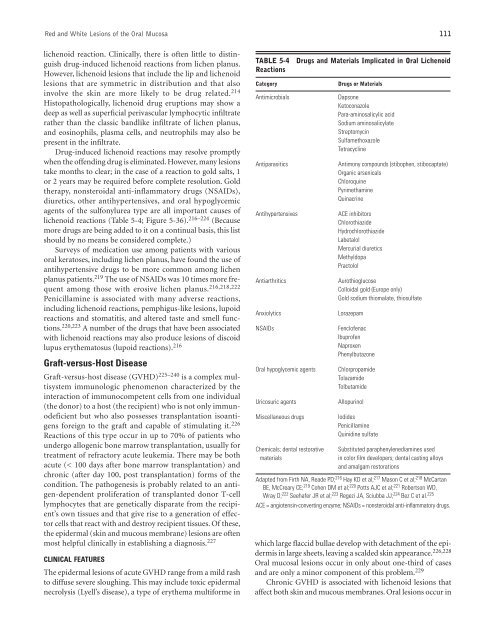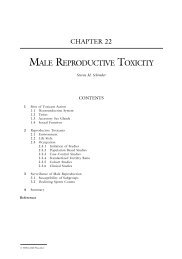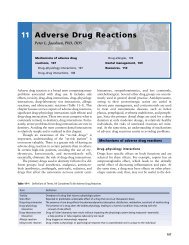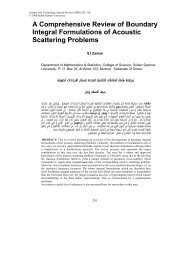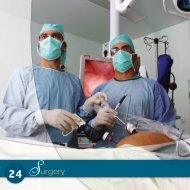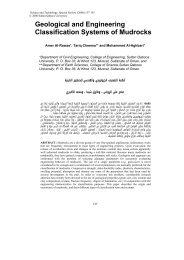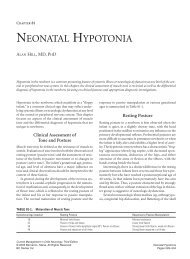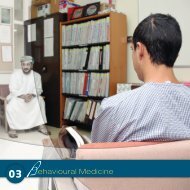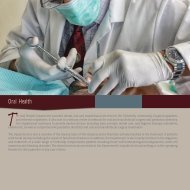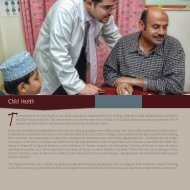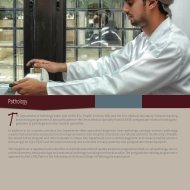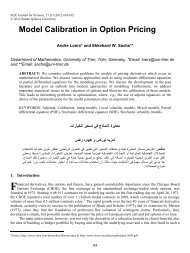Ch05: Red and White Lesions of the Oral Mucosa
Ch05: Red and White Lesions of the Oral Mucosa
Ch05: Red and White Lesions of the Oral Mucosa
You also want an ePaper? Increase the reach of your titles
YUMPU automatically turns print PDFs into web optimized ePapers that Google loves.
<strong>Red</strong> <strong>and</strong> <strong>White</strong> <strong>Lesions</strong> <strong>of</strong> <strong>the</strong> <strong>Oral</strong> <strong>Mucosa</strong> 111<br />
lichenoid reaction. Clinically, <strong>the</strong>re is <strong>of</strong>ten little to distinguish<br />
drug-induced lichenoid reactions from lichen planus.<br />
However, lichenoid lesions that include <strong>the</strong> lip <strong>and</strong> lichenoid<br />
lesions that are symmetric in distribution <strong>and</strong> that also<br />
involve <strong>the</strong> skin are more likely to be drug related. 214<br />
Histopathologically, lichenoid drug eruptions may show a<br />
deep as well as superficial perivascular lymphocytic infiltrate<br />
ra<strong>the</strong>r than <strong>the</strong> classic b<strong>and</strong>like infiltrate <strong>of</strong> lichen planus,<br />
<strong>and</strong> eosinophils, plasma cells, <strong>and</strong> neutrophils may also be<br />
present in <strong>the</strong> infiltrate.<br />
Drug-induced lichenoid reactions may resolve promptly<br />
when <strong>the</strong> <strong>of</strong>fending drug is eliminated. However, many lesions<br />
take months to clear; in <strong>the</strong> case <strong>of</strong> a reaction to gold salts, 1<br />
or 2 years may be required before complete resolution. Gold<br />
<strong>the</strong>rapy, nonsteroidal anti-inflammatory drugs (NSAIDs),<br />
diuretics, o<strong>the</strong>r antihypertensives, <strong>and</strong> oral hypoglycemic<br />
agents <strong>of</strong> <strong>the</strong> sulfonylurea type are all important causes <strong>of</strong><br />
lichenoid reactions (Table 5-4; Figure 5-36). 216–224 (Because<br />
more drugs are being added to it on a continual basis, this list<br />
should by no means be considered complete.)<br />
Surveys <strong>of</strong> medication use among patients with various<br />
oral keratoses, including lichen planus, have found <strong>the</strong> use <strong>of</strong><br />
antihypertensive drugs to be more common among lichen<br />
planus patients. 219 The use <strong>of</strong> NSAIDs was 10 times more frequent<br />
among those with erosive lichen planus. 216,218,222<br />
Penicillamine is associated with many adverse reactions,<br />
including lichenoid reactions, pemphigus-like lesions, lupoid<br />
reactions <strong>and</strong> stomatitis, <strong>and</strong> altered taste <strong>and</strong> smell functions.<br />
220,223 A number <strong>of</strong> <strong>the</strong> drugs that have been associated<br />
with lichenoid reactions may also produce lesions <strong>of</strong> discoid<br />
lupus ery<strong>the</strong>matosus (lupoid reactions). 216<br />
Graft-versus-Host Disease<br />
Graft-versus-host disease (GVHD) 225–240 is a complex multisystem<br />
immunologic phenomenon characterized by <strong>the</strong><br />
interaction <strong>of</strong> immunocompetent cells from one individual<br />
(<strong>the</strong> donor) to a host (<strong>the</strong> recipient) who is not only immunodeficient<br />
but who also possesses transplantation isoantigens<br />
foreign to <strong>the</strong> graft <strong>and</strong> capable <strong>of</strong> stimulating it. 226<br />
Reactions <strong>of</strong> this type occur in up to 70% <strong>of</strong> patients who<br />
undergo allogenic bone marrow transplantation, usually for<br />
treatment <strong>of</strong> refractory acute leukemia. There may be both<br />
acute (< 100 days after bone marrow transplantation) <strong>and</strong><br />
chronic (after day 100, post transplantation) forms <strong>of</strong> <strong>the</strong><br />
condition. The pathogenesis is probably related to an antigen-dependent<br />
proliferation <strong>of</strong> transplanted donor T-cell<br />
lymphocytes that are genetically disparate from <strong>the</strong> recipient’s<br />
own tissues <strong>and</strong> that give rise to a generation <strong>of</strong> effector<br />
cells that react with <strong>and</strong> destroy recipient tissues. Of <strong>the</strong>se,<br />
<strong>the</strong> epidermal (skin <strong>and</strong> mucous membrane) lesions are <strong>of</strong>ten<br />
most helpful clinically in establishing a diagnosis. 227<br />
CLINICAL FEATURES<br />
The epidermal lesions <strong>of</strong> acute GVHD range from a mild rash<br />
to diffuse severe sloughing. This may include toxic epidermal<br />
necrolysis (Lyell’s disease), a type <strong>of</strong> ery<strong>the</strong>ma multiforme in<br />
TABLE 5-4 Drugs <strong>and</strong> Materials Implicated in <strong>Oral</strong> Lichenoid<br />
Reactions<br />
Category Drugs or Materials<br />
Antimicrobials Dapsone<br />
Ketoconazole<br />
Para-aminosalicylic acid<br />
Sodium aminosalicylate<br />
Streptomycin<br />
Sulfamethoxazole<br />
Tetracycline<br />
Antiparasitics Antimony compounds (stibophen, stibocaptate)<br />
Organic arsenicals<br />
Chloroquine<br />
Pyrimethamine<br />
Quinacrine<br />
Antihypertensives ACE inhibitors<br />
Chlorothiazide<br />
Hydrochlorothiazide<br />
Labetalol<br />
Mercurial diuretics<br />
Methyldopa<br />
Practolol<br />
Antiarthritics Aurothioglucose<br />
Colloidal gold (Europe only)<br />
Gold sodium thiomalate, thiosulfate<br />
Anxiolytics Lorazepam<br />
NSAIDs Fencl<strong>of</strong>enac<br />
Ibupr<strong>of</strong>en<br />
Naproxen<br />
Phenylbutazone<br />
<strong>Oral</strong> hypoglycemic agents Chlorpropamide<br />
Tolazamide<br />
Tolbutamide<br />
Uricosuric agents Allopurinol<br />
Miscellaneous drugs Iodides<br />
Penicillamine<br />
Quinidine sulfate<br />
Chemicals; dental restorative Substituted paraphenylenediamines used<br />
materials in color film developers; dental casting alloys<br />
<strong>and</strong> amalgam restorations<br />
Adapted from Firth NA, Reade PD; 216 Hay KD et al; 217 Mason C et al; 218 McCartan<br />
BE, McCreary CE; 219 Cohen DM et al; 220 Potts AJC et al; 221 Robertson WD,<br />
Wray D; 222 Seehafer JR et al; 223 Regezi JA, Sciubba JJ; 224 Bez C et al. 225<br />
ACE = angiotensin-converting enzyme; NSAIDs = nonsteroidal anti-inflammatory drugs.<br />
which large flaccid bullae develop with detachment <strong>of</strong> <strong>the</strong> epidermis<br />
in large sheets, leaving a scalded skin appearance. 226,228<br />
<strong>Oral</strong> mucosal lesions occur in only about one-third <strong>of</strong> cases<br />
<strong>and</strong> are only a minor component <strong>of</strong> this problem. 229<br />
Chronic GVHD is associated with lichenoid lesions that<br />
affect both skin <strong>and</strong> mucous membranes. <strong>Oral</strong> lesions occur in


